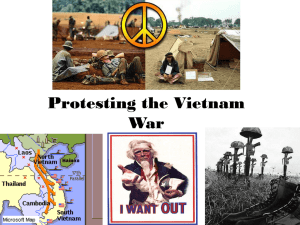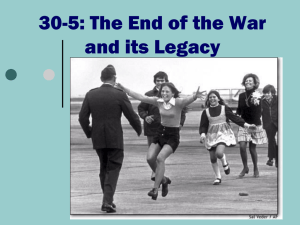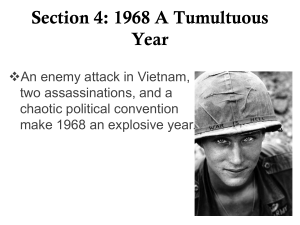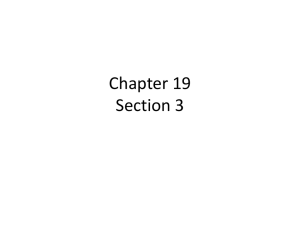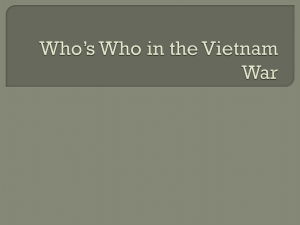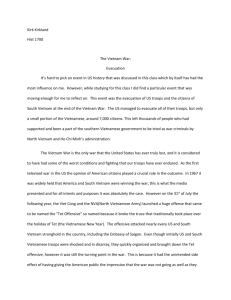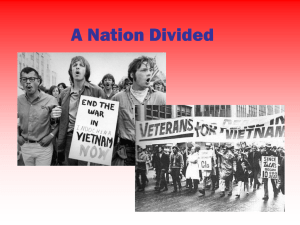Chapter 52 - Cloudfront.net
advertisement
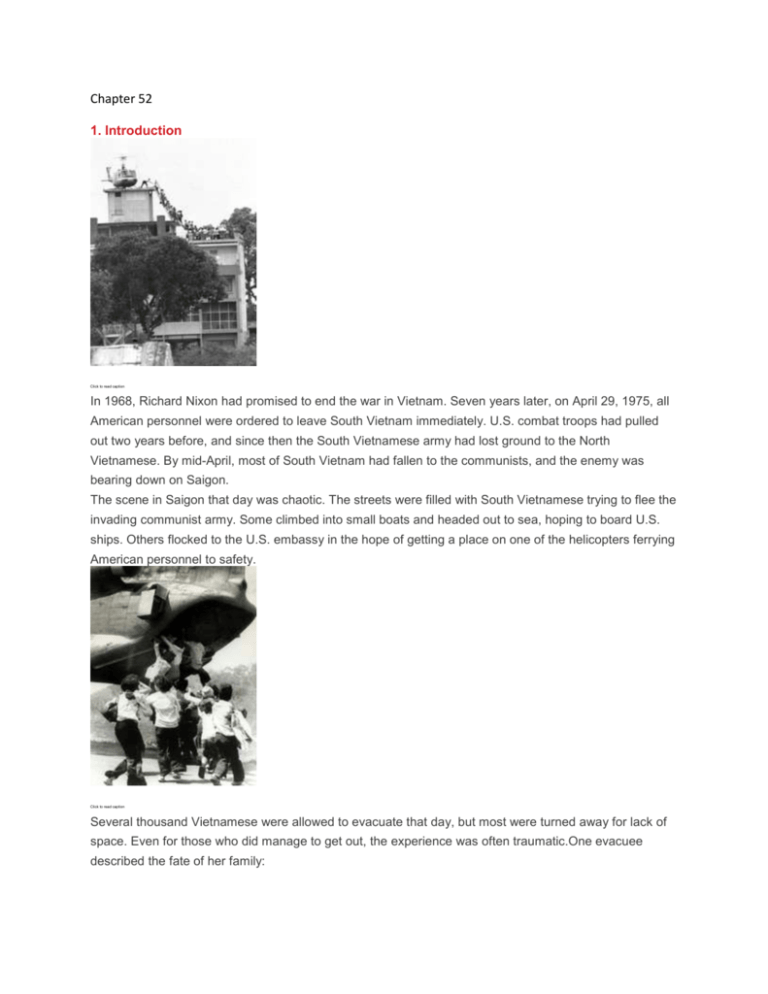
Chapter 52 1. Introduction Click to read caption In 1968, Richard Nixon had promised to end the war in Vietnam. Seven years later, on April 29, 1975, all American personnel were ordered to leave South Vietnam immediately. U.S. combat troops had pulled out two years before, and since then the South Vietnamese army had lost ground to the North Vietnamese. By mid-April, most of South Vietnam had fallen to the communists, and the enemy was bearing down on Saigon. The scene in Saigon that day was chaotic. The streets were filled with South Vietnamese trying to flee the invading communist army. Some climbed into small boats and headed out to sea, hoping to board U.S. ships. Others flocked to the U.S. embassy in the hope of getting a place on one of the helicopters ferrying American personnel to safety. Click to read caption Several thousand Vietnamese were allowed to evacuate that day, but most were turned away for lack of space. Even for those who did manage to get out, the experience was often traumatic.One evacuee described the fate of her family: When we got the signal that we could leave, my family divided into two. My four brothers went with my uncle’s family. My three sisters and I went with my parents. We left by boat, my brothers and my uncle went by helicopter. We’ve never found them. My parents tried to find them through the American Red Cross. They looked everywhere but have never found them. My parents lost four sons. It was a very painful experience. We still aren’t over it . . . and probably never will be. —Anne Pham, in “Memories of the Fall of Saigon,” CBS News President Nixon had hoped to arrange a peaceful end to the Vietnam War that would leave South Vietnam free and independent.Why did the United States fail to achieve that goal? This chapter examines the final years of the war and some views of lessons that emerged from the conflict. 2. Nixon's Dilemma: Achieving "Peace with Honor" Click to read caption President Nixon entered the White House with a mandate to change the course of the Vietnam War. To that end, he relied heavily on his national security adviser, Henry Kissinger. Nixon and Kissinger drew two basic conclusions about Vietnam. First, they agreed that the war was not winnable, at least in the conventional sense. U.S. forces could not fight their way into Hanoi the way the Allies had entered Berlin in World War II. The political costs, and the cost in American lives, would be too great. Second, they decided that the United States could not just “cut and run.” An abrupt withdrawal from Vietnam would damage U.S. credibility by showing both friends and foes that the United States could not be trusted to stand by its allies. Instead, Nixon sought to achieve “peace with honor.” He wanted to end the war in a way that left the reputation of the United States intact. Nixon decided on a carrot-and-stick approach—a tactic that combines actions that reward (the “carrot”) with actions that punish (the “stick”). Using this approach, he hoped to persuade the North Vietnamese to accept a negotiated end to the war. The Carrot: Peace Talks and Vietnamization Peace talks had begun in Paris in May 1968, but little progress had been made. In 1969, Nixon sent Kissinger to Paris to reopen talks with North Vietnamese diplomats. Kissinger proposed ending the bombing of the North—the “carrot”—in exchange for an agreement by both sides to withdraw their troops from South Vietnam. But he insisted that South Vietnam remain independent. The North Vietnamese rejected this offer as a “farce,” saying they were prepared to remain in Paris “until the chairs rot.” When diplomacy failed to bring about “peace with honor,” Nixon decided to try another approach known as Vietnamization. South Vietnam, he said, would gradually take over conduct of the war, while American GIs would steadily be withdrawn. In this way, Nixon could offer the “carrot” of troop reductions to North Vietnam, while easing antiwar tensions at home. Vietnamization was part of a broader Asian policy that called for each American ally to accept primary responsibility for providing soldiers for its own defense. The number of U.S. troops in Vietnam peaked in March 1969 at 543,000. By the end of the year, more than 60,000 of those soldiers would be withdrawn. Click to read caption The plan for Vietnamization set three main goals for South Vietnam: self-government, self-development, and self-defense. According to this plan, political reforms, including local elections, would increase popular participation in government and provide for essential public services. Rural development would bring economic opportunity to the countryside, while pacification would create local self-defense forces to take charge of village security. U.S. officials believed that strengthening South Vietnam’s military forces was key to making Vietnamization work. Training schools were expanded. Pay for soldiers in South Vietnam’s army (ARVN) was increased. Living conditions in military camps were improved. So many U.S. ships, planes, helicopters, and vehicles were shipped to Vietnam that one Congressman wondered whether the goal of Vietnamization was to “put every South Vietnamese soldier behind the wheel.” The Stick: Widening the Air War and Invading Cambodia Vietnamization would be a long process, and many American officials were pessimistic about its prospects.Meanwhile, negotiations in Paris were proving fruitless. The “carrot” offered by the United States—U.S. troop withdrawals and an end to bombing—did not satisfy the North Vietnamese. Nixon considered several military options to pressure North Vietnam to negotiate, including bombing its industrial areas, mining its harbors, and invading its territory. His strategy, which he called the “madman theory,” was to make North Vietnam’s leaders and their allies, the Soviet Union and China, believe that he would do anything to win the war. He even briefly put nuclear forces on alert as a bluff that he might use tactical nuclear weapons, small but highly destructive nuclear bombs. Nixon had already shown a willingness to expand the war. In March 1969, he had secretly ordered B-52s to begin bombing Cambodia, a neutral nation on Vietnam’s western border. For the next four years, U.S. bombers would strike communist base camps and supply lines in Cambodia. With Vietnamization, U.S. ground forces began focusing more on intercepting supplies from the north and less on fighting guerrillas in the south. Nixon also decided to give those ground forces another mission. In April 1970, he ordered U.S. troops to invade Cambodia. The military goal of the invading U.S. force was to destroy enemy “safe havens” from which North Vietnamese Army (NVA) and Viet Cong forces could launch assaults into South Vietnam. The political goal, said Nixon, was to “show the enemy that we were still serious about our commitment in Vietnam.” The invasion was a partial success. The GIs destroyed enemy bases and relieved pressure on ARVN forces fighting in the south. But the invasion did not help the peace process. The communists boycotted the Paris talks until U.S. troops left Cambodia three months later. In February 1971, Nixon launched a similar invasion of Laos, another neighboring country, after years of bombing had failed to dislodge the communists. By now, the steady withdrawal of GIs had left fewer than 175,000 U.S. combat soldiers in Vietnam. ARVN troops carried out the ground fighting in Laos, with U.S. air support.However, a large, well-equipped NVA force easily defeated the ARVN, forcing them to retreat. So far, Vietnamization had failed to prove its worth on the battlefield. 3. The Expanded War Sparks Increased Protest Click to read caption Vietnamization dampened antiwar protests for a while. On November 12, 1969, journalist Seymour Hersh published an article describing a grisly killing spree at My Lai, a village in South Vietnam. The My Lai Massacre had taken place in March 1968 but had been covered up by the military. U.S. soldiers, believing My Lai to be a Viet Cong stronghold, had gone there on a search-and-destroy mission. To their surprise, they found no armed Viet Cong in the village, just women, children, and old men. Nevertheless, one morning the soldiers rounded up and executed about 500 of these civilians. Only a handful of villagers survived. News of the massacre shocked Americans, though many doubted that such an atrocity could occur. Others believed the soldiers were just following orders or that their actions were justified. Enough Americans expressed outrage, though, that Nixon decided to accelerate the withdrawal of troops from Vietnam. Demonstrations Increase on City Streets and College Campuses The news of My Lai added fuel to an already growing antiwar movement. About a month before, on October 15, 1969, peace activists had staged the biggest antiwar demonstration in U.S. history: the nationwide Vietnam Moratorium Day. A moratorium is a suspension of activity. Organizers asked Americans to take the day off to reflect on the war. More than 2 million people—not only students but also older, middle-class Americans— responded in a day of dramatic and widespread protest. They took part in rallies and marches, attended church services, and engaged in discussions. About 250,000 demonstrators came to the nation’s capital. In one of the protest activities, tens of thousands of them marched from the Washington Monument to the White House, where they held a candlelight vigil. Click to read caption Nixon responded to this outpouring of antiwar sentiment with a televised speech on November 3. He reminded viewers of his Vietnamization policy and his plan for withdrawing U.S. troops. He ended with an appeal for support from “the great silent majority of my fellow Americans.” And he warned that “the more divided we are at home, the less likely the enemy is to negotiate at Paris.” Nixon’s speech quieted the antiwar movement for a time. The invasion of Cambodia in 1970, however, brought another upsurge in protests. Students held mass rallies and demonstrations, some of which turned violent. The Kent State shootings were the most shocking example. On May 4, students at Kent State University in Ohio were holding a peace rally after several days of violent unrest, which included the burning of the army’s Reserve Officers’ Training Corps (ROTC) building on campus. National Guard troops, called out to quell the protests, ordered the crowd to disperse. After some students began chanting slogans and throwing rocks, the troops opened fire. Four students were killed and nine were wounded. Ten days later, a similar incident took place at Jackson State College in Mississippi. Protesters threw debris at police, and the officers responded with shotgun and machine-gun fire that left two students dead. Click to read caption Reactions to these incidents varied. Many Americans were stunned, and protests erupted on college campuses and in cities across the nation. Vietnam veterans took part in some of these protests, as did several labor unions. Nevertheless, only a small percentage of Americans ever demonstrated publicly. In fact, many Americans rejected antiwar protests, seeing them as unpatriotic and disruptive. In May 1970, construction workers in New York City showed their disgust with antiwar demonstrators by holding marches in support of the war. Some soldiers also wrote home asking for public support. An army nurse wrote her parents, saying, “Display the flag, Mom and Dad . . . And tell your friends to do the same. It means so much to us to know we’re supported, to know not everyone feels we’re making a mistake being here.” The Pentagon Papers Raise New Questions About the War Nixon soon had other problems to contend with. In 1971, a former Department of Defense official, Daniel Ellsberg, leaked a top-secret study known as the Pentagon Papers to the New York Times. This study revealed how previous administrations had deceived Congress and the public about Vietnam. Nixon feared that release of this document might lead to questions about his own policies and the secret actions he was taking in Vietnam. Government lawyers won a temporary restraining order to stop further publication of the Pentagon Papers. Their appeal for a permanent injunction went to the Supreme Court. On June 30, 1971, in the case New York Times Co. v. United States, the Court ruled 6–3 against the government and in favor of free speech. In their opinion, the government had not proved the need for prior restraint, the prevention of speech or expression before publication. Congress Responds to Widening War After the invasion of Cambodia, antiwar members of Congress intensified their efforts. By the end of 1970, they had repealed the Gulf of Tonkin Resolution, which had allowed Johnson and Nixon to escalate the conflict without a formal declaration of war. In February 1971, Congress passed legislation forbidding U.S. troops from operating outside the borders of South Vietnam. Two years later, when Congress learned that Nixon had secretly bombed Cambodia without congressional approval, it passed the War Powers Resolution. This law placed strict limits on a president’s power to use the armed forces in hostilities without congressional authorization. By then, support in Congress for the war had greatly declined. 4. American Involvement in the War Ends Click to read caption By the time Nixon entered office in 1969, some 30,000 Americans had already died in Vietnam. During his first year as president, 11,500 more died and 55,000 were wounded. Over the next three years, however, Vietnamization drastically cut U.S. casualties, as more and more soldiers came home. Their ARVN replacements, though, had not yet shown they could stand up to an NVA assault.They got another chance in the spring of 1972. On March 30, North Vietnamese troops backed by tanks and artillery invaded South Vietnam. They smashed through the ARVN defenders at the border. The U.S. military, with just 6,000 soldiers left in the country, provided airpower to counter the invasion.Then Nixon took a bolder step. In April, for the first time since 1969, he unleashed U.S. bombers on North Vietnam. He also ordered the mining of Haiphong and other North Vietnamese ports, where war supplies from the Soviet Union and China arrived. His stated goal was to “destroy the enemy’s war-making capacity.” By mid-June, the North’s offensive had been shut down, and ARVN forces had begun pushing the invaders back. Nixon Declares “Peace Is at Hand” North Vietnam’s failed invasion caused it to soften its stand at the secret Paris peace talks.North Vietnamese negotiators withdrew their demand that South Vietnam’s government share power with the Viet Cong. For its part, the United States stopped its bombing and agreed that some NVA forces could stay in the south. These compromises allowed Henry Kissinger to reach an agreement with Hanoi’s diplomats. At a news conference less than two weeks before the 1972 presidential election, Kissinger announced, “We believe that peace is at hand.” By that time, polls showed that Nixon already had a large lead over Democratic candidate George McGovern, an antiwar senator. Nixon went on to win a second term in a landslide. But peace was not at hand. South Vietnam’s president, Nguyen Van Thieu, feared that the United States was abandoning his country to the communists. He insisted on dozens of changes to the Paris agreement. Learning of the changes, Hanoi’s leaders backed out, and the peace talks collapsed. Frustrated by the failed talks, Nixon decided to punish the north. On December 14, he ordered a series of B-52 and fighter-bomber attacks on Hanoi and Haiphong.Known as the Christmas bombings, this aerial campaign reached an intensity not previously seen in the war. One NVA leader said it was “like living through a typhoon with trees crashing down and lightning transforming night into day.” Nixon hoped to destroy North Vietnam’s will to fight. He also wanted to show President Thieu that after peace came, the United States would use its might to enforce the terms of the treaty. Click to read caption North Vietnam returned to the bargaining table, and South Vietnam agreed to the earlier proposals.By late January, the negotiators had a final treaty ready to sign. On January 27, 1973, representatives of the United States, South Vietnam, North Vietnam, and the Viet Cong signed the Paris Peace Accords. This treaty set the goal of “ending the war and restoring peace in Vietnam.” To that end, it established a cease-fire and kept the dividing line between North and South Vietnam at the 17th parallel. It also called for the withdrawal of all U.S. troops and the release of all U.S. prisoners of war. Veterans and Prisoners of War Return Home By March 29, 1973, the United States had withdrawn all combat forces from Vietnam. Arriving home, many soldiers were dismayed to find themselves the victims of their country’s bitter debate over the war. Unlike soldiers returning from World War II, most Vietnam veterans were not treated like heroes. Few communities welcomed their soldiers back with parades or celebrations. Instead, Vietnam veterans were often shunned or simply ignored by the general public. As a result, they did not receive the support and understanding they deserved for their service and sacrifices. Click to read caption For combat veterans especially, the Vietnam War had been a harrowing experience. Many soldiers were haunted by their fears in battle and by the death and destruction they had witnessed.They rarely talked about their combat experiences, except with other veterans. Of the 2.6 million Americans who served in Vietnam, nearly a half million suffered from post-traumatic stress disorder. Symptoms of this mental illness include anxiety, irritability, nightmares, and depression. More than 760 Americans were taken prisoner by the North Vietnamese. Of these prisoners of war, or POWs, at least 110 died in captivity. The typical POW was a pilot whose plane had been shot down. POWs lived in miserable conditions, often in solitary confinement, and they faced regular interrogations and torture. One former POW described his experience in a Hanoi prison: From the moment you enter a political prison, you are told and forced to act as though you are subhuman—a dreg of society.And there’s every effort made . . . to remind you daily that they’re looking at you: You’re not to look at the sky. That’s enough to give you a left hook to the jaw. You’re to bow down. You have no rights. You have no name. You have no nationality. You are a criminal. You are a worm. —Navy pilot James Stockdale, shot down in 1965 North Vietnam had released all POWs by April 1, 1973. Another 2,600 Americans were MIA, or missing in action. Some 1,800 MIAs are still un-accounted for today.Few, if any, are thought to be alive. 5. The War in Vietnam Comes to an End After the withdrawal of U.S. ground forces from Vietnam, President Thieu and the ARVN continued to depend on U.S. airpower. American bombers and fighter jets had played a critical part in the war, and the South Vietnamese relied on Nixon’s promise to “respond with full force” if North Vietnam violated the cease-fire. “You can be sure,” Nixon said to Thieu in April 1973, “that we stand with you as we continue to work together to build a lasting peace.” South Vietnam Falls to the Communist North The cease-fire did not hold for long. In 1973 and 1974, fierce fighting between insurgents and the ARVN left some 50,000 ARVN soldiers dead. Meanwhile, North Vietnam readied a final invasion of the south by rebuilding its army and military apparatus. In March 1975, the NVA launched an all-out offensive. As ARVN forces scattered in the face of the assault, Thieu pleaded with the United States for help. President Gerald Ford, who succeeded Nixon in 1974, urged Congress to boost military aid. But he did not demand that U.S. forces return to Vietnam. In a speech on April 23, 1975, Ford said, “America can regain the sense of pride that existed before Vietnam. But it cannot be achieved by refighting a war that is finished as far as America is concerned.” Four days after Ford’s speech, the NVA had surrounded Saigon. As panic gripped the city, U.S. embassy personnel worked frantically to evacuate more than a thousand Americans and several thousand frantic South Vietnamese. Helicopters airlifted most of them from the embassy rooftop to U.S. ships waiting offshore. Early on April 30, NVA tanks and troops entered Saigon unopposed. President Thieu had resigned and fled nine days earlier. His replacement, Duong Van Minh, surrendered unconditionally. “I declare that the Saigon government, from central to local level, has been completely dissolved,” he said. The Vietnam War, and South Vietnam itself, had come to an end. Click to read caption The Aftermath of the War in Southeast Asia The end of the war did not bring an end to suffering in Vietnam. Nor did it end the suffering in Cambodia and Laos, where separate communist revolts had occurred. Local communist insurgents took over in both of those countries and worked to convert the people to communism. In Vietnam, communists seized private property and nationalized businesses. Many anticommunists had feared a bloodbath, but instead the communists sent hundreds of thousands of people—including ARVN officers, government officials, scholars, and religious leaders—to “reeducation camps,” where they were subjected to hard labor. They also relocated hundreds of thousands of city residents to rural “economic zones” to toil on collective farms. Faced with these circumstances, more than a million South Vietnamese have fled the country since 1975. Because many left by boat, they became known as the boat people. A great majority of these refugees eventually settled in the United States. A similar period of turmoil followed the communist takeover in Laos. This social upheaval produced some 350,000 refugees. But Cambodians had the worst experience by far. The communist regime there, called the Khmer Rouge, immediately cleared out all urban areas, forcing about 3 million city dwellers to work at hard labor on farms. Nearly 1.7 million Cambodian officials, merchants, members of minority groups, and others were worked to death, starved to death, or killed outright. The Aftermath of the War in the United States The Vietnam War left the United States in a state of shock. More than 58,000 soldiers died in the war and another 300,000 were wounded, many of them losing limbs. To some Americans, the soldiers’ sacrifices seemed pointless. The United States, after all, had lost the war—a war that could have been avoided. To others, failure to win the war suggested that the nation lacked the will to be a world leader. For several years after the war, Americans tried to forget about Vietnam. The memories were too painful. Yet those memories also led to changes. The country reduced, for a while, its involvement in global conflicts. Also, because of the credibility gap fostered by government officials, Americans no longer automatically trusted what their leaders told them. A monument erected in 1982 helped many Americans—especially Vietnam veterans—come to terms with the war. The Wall, part of the Vietnam Veterans Memorial in Washington, D.C., encouraged Americans to reflect on the conflict and thus heal some of the war’s wounds. Many veterans, after seeing the Wall, finally felt they had come home. Summary In 1969, President Nixon began withdrawing U.S. troops from Vietnam, but the war continued throughout his time in office. He carried on peace talks with the North Vietnamese but also ordered massive bombing of North Vietnam, Cambodia, and Laos. He faced ongoing protests from the antiwar movement and criticism from Congress. In 1973, the last U.S. combat forces came home. North Vietnam swept to victory over the South in 1975. Vietnamization Nixon’s Vietnamization of the war allowed for the withdrawal of U.S. troops and prepared South Vietnam to take over responsibility for the war. My Lai massacre In 1968, U.S. soldiers slaughtered hundreds of Vietnamese civilians in the village of My Lai. Reports of the massacre shocked Americans and increased antiwar protests. Kent State shootings The invasion of Cambodia in April 1970 sparked an increase in antiwar protests. The most violent one occurred the following month at Kent State University in Ohio, where National Guard troops fired into an angry crowd, killing four students. War Powers Resolution Congress reacted to Nixon’s activities in Cambodia by passing the War Powers Resolution. This resolution limits a president’s ability to send armed forces into combat. Pentagon Papers In 1971, Daniel Ellsberg leaked to the press a top-secret study of the U.S. role in Indochina. This study, the Pentagon Papers, revealed secrecy and deceit on the part of U.S. presidents. Boat people The North Vietnamese defeated South Vietnam and took control in 1975. This prompted an exodus of refugees from Indochina, many of whom fled by boat.
![vietnam[1].](http://s2.studylib.net/store/data/005329784_1-42b2e9fc4f7c73463c31fd4de82c4fa3-300x300.png)
